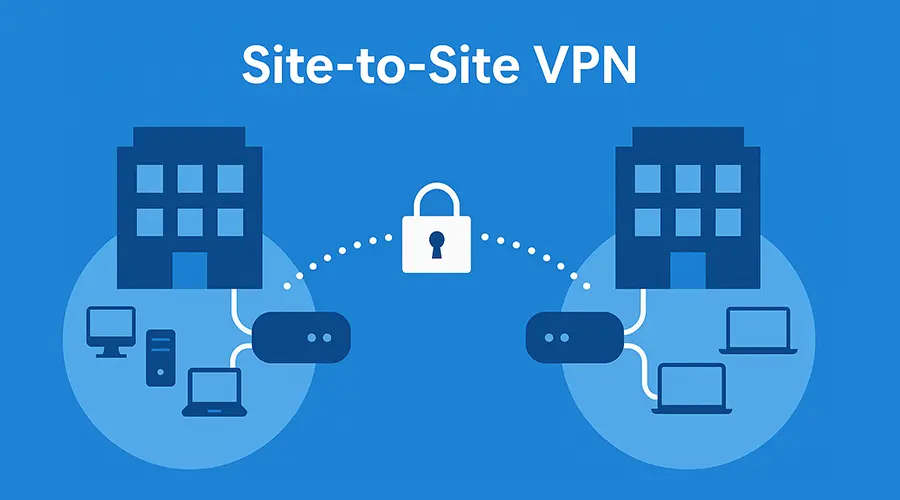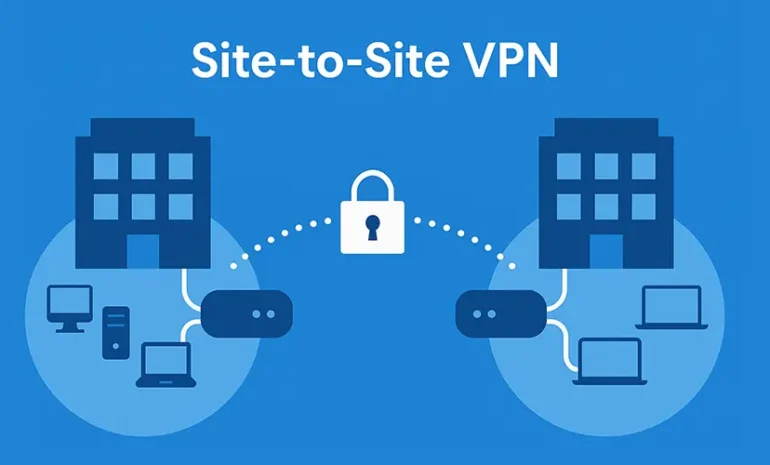A site-to-site VPN (Virtual Private Network) is a secure method of linking multiple local area networks (LANs) across different physical locations through encrypted tunnels over the internet. It’s primarily used by businesses or organizations with several branch offices that need to securely access shared resources.
Unlike traditional consumer VPNs that connect individual devices to a server, site-to-site VPNs connect entire networks. This approach builds a secure and scalable wide area network (WAN) without relying on expensive private lines.
How Does a Site-to-Site VPN Work?
The basic architecture of a site-to-site VPN involves VPN gateways — typically routers or firewalls — located at each office. These gateways manage encryption and decryption of traffic as it travels between sites.
Here’s a simplified flow:
- Office A and Office B each have their LANs.
- Each office deploys a VPN-capable router as a gateway.
- These routers establish an encrypted VPN tunnel between them.
- Devices in Office A send data to devices in Office B through this tunnel, and vice versa — without needing any VPN client software on end-user devices.
This setup ensures all inter-office communication is encrypted and secure, even when passing through the public internet.
Site-to-Site VPN vs Remote Access VPN
| Feature | Site-to-Site VPN | Remote Access VPN |
|---|---|---|
| Purpose | Connects networks (LANs) | Connects individual devices |
| Best for | Offices, enterprises | Remote workers, travelers |
| Client software needed | No | Yes |
| Flexibility | Less flexible | Highly flexible |
| Access control | Through network infrastructure | Through VPN client settings |
Remote access VPNs are designed for users needing to connect securely from outside a trusted network — like home or public Wi-Fi. In contrast, site-to-site VPNs ensure seamless interconnection between entire networks, useful when resources need to be accessed across offices without user-level management.
Benefits of a Site-to-Site VPN
Enhanced Security for Data in Transit
Encrypted VPN tunnels ensure that information exchanged between offices is shielded from cyber threats and eavesdropping.
Streamlined Operations
File sharing, database access, VoIP systems, and internal applications are accessible across sites as if they were under one roof.
No Need for VPN Clients
Devices on the LAN connect securely without requiring users to install or configure software — simplifying IT deployment and reducing user error.
Consistent Access
Ideal for companies with stable office setups — site-to-site VPNs provide always-on connectivity without needing to reconnect manually.
Limitations of Site-to-Site VPNs
- Not suitable for remote workers. Employees outside the corporate LAN can’t benefit from the VPN unless they connect through office gateways.
- Limited endpoint privacy. Once traffic leaves the VPN tunnel and reaches a device, it’s no longer encrypted.
- More complex to manage across many locations. Maintaining separate gateways at each site adds administrative overhead.
Types of Site-to-Site VPNs
1. Intranet VPN
Connects multiple branches of the same organization for full data and application access.
2. Extranet VPN
Connects two or more different organizations, allowing shared access to specific resources while restricting others — ideal for partnerships and vendor collaborations.
Is a Site-to-Site VPN Private?
Yes — but only during transit. The encrypted tunnel protects data between locations, but once it reaches the destination LAN, standard internal network security measures must take over. That’s why combining a site-to-site VPN with strong endpoint security is crucial.
Is a Site-to-Site VPN Right for Your Business?
If you run a business with multiple branches that need to collaborate in real time while keeping data protected, a site-to-site VPN is a powerful solution. Whether it’s for internal communication, secure file access, or centralized applications, this model ensures performance and security at scale.
However, if you also have a remote or hybrid workforce, combining site-to-site VPNs with remote access VPNs is ideal.
Why Choose Vpnymous for Your Site-to-Site VPN Setup?
Vpnymous offers enterprise-grade VPN solutions tailored for both multi-office setups and remote workforce needs. Our platform supports:
- Secure OpenVPN and WireGuard tunneling for site-to-site configurations
- Easy integration with popular firewalls and routers
- Crypto-only payments — no personal info required
- Fully open-source clients for maximum transparency
- Zero logging, zero tracking — guaranteed
FAQs – Site-to-Site VPN
What devices do I need to set up a site-to-site VPN?
You’ll need VPN-capable routers or firewalls at each site and a stable internet connection.
Is a site-to-site VPN hard to configure?
Vpnymous provides step-by-step guides and support to help configure OpenVPN or WireGuard tunnels on most routers and firewalls.
Can freelancers or remote workers use this type of VPN?
Site-to-site VPNs are designed for office-based devices. For remote users, Vpnymous recommends a secure remote access VPN instead.
Is my data safe if intercepted?
Yes. The data is encrypted between VPN gateways. Anyone intercepting it would see only scrambled, unreadable data.
Can I combine site-to-site and remote access VPNs?
Absolutely. Vpnymous supports hybrid setups to cover office networks and off-site users with equal protection.


